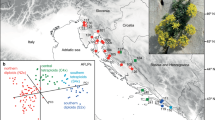Abstract
In Britain the genus Euphrasia comprises ca 20 diploid and tetraploid plant species, including several endemics. However, their conservation is impeded by taxonomic uncertainty. Analysis of cpDNA and AFLP variation was used to assess their taxonomic status and establish the extent of barriers to gene exchange among them. Differences in ploidy level constitute a very strong barrier to genetic exchange, although this is not absolute. The diploid endemics E. vigursii and E. rivularis form morphologically and genetically definable units which show some level of reproductive isolation. Within tetraploid Euphrasia, the species showed varying degrees of distinctness. Analysis of geographically paired samples from two widespread outcrossing taxa E. arctica and E. nemorosa provides evidence for extensive genetic exchange between them. However AFLP data indicate that this outbreeding species complex possesses a gene pool distinct from that of the widespread inbreeding tetraploids. The widespread and endemic inbreeding tetraploids contain examples of morphologically and genetically definable taxa, but also species whose distinctness is more equivocal. The conservation implications of this study are that species-based action plans are potentially suitable for conservation of the diploid endemics E. vigursii and E. rivularis. In contrast we contend that a species-based conservation framework, developed with reproductively isolated and genetically distinct groups in mind, requires modification for conservation of the complex and dynamic diversity found within the tetraploids. The adoption of ‘taxonomic’ action plans, designed to protect the evolutionary processes generating Euphrasia diversity, may provide a supplementary solution for conserving this type of variation.






Similar content being viewed by others
References
Cheffings CM, Farrell L (eds) (2005) The vascular plant red data list for Great Britain. JNCC, Peterborough
Demesure B, Sodzi N, Petit RJ (1995) A set of universal primers for amplification of polymorphic non-coding regions of mitochondrial and chloroplast DNA in plants. Mol Ecol 4:129–131
Doyle JJ, Doyle JL (1987) A rapid DNA isolation procedure for small quantities of fresh leaf material. Phytochem Bull 19:11–15
Ennos RA, French GC, Hollingsworth PM (2005) Conserving taxonomic complexity. Trends Ecol Evol 20:164–168
Excoffier L, Smouse PE, Quattro JM (1992) Analysis of molecular variance inferred from metric distances among DNA haplotypes: application to human mitochondrial DNA restriction data. Genetics 131:479–491
French GC, Ennos RA, Silverside AJ, Hollingsworth PM (2005) The relationship between flower size, inbreeding coefficient and inferred selfing rate in British Euphrasia species. Heredity 94:44–51
Gomez JM (2002) Self-pollination in Euphrasia willkommii Freyn (Scrophulariaceae), an endemic species from the alpine of the Sierra Nevada (Spain). Plant Syst Evol 232:63–71
Hollingsworth PM, Squirrell J, Hollingsworth ML, Richards AJ, Bateman RM (2006) Taxonomic complexity, conservation and recurrent origins of self-pollination in Epipactis (Orchidaceae). In: Bailey JP, Ellis RG (eds) Current taxonomic research on the British and European Flora. BSBI, London, pp 27–44
Karlsson T (1982) Euphrasia rostkoviana i Sverige. Vaxtekol Stud 15:1–116
Liebst B, Schneller J. (2005) How selfing and intra- and interspecific crossing influence seed set, morphology and ploidy level in Euphrasia: An experimental study of species occurring in the Alps of Switzerland. Plant Syst Evol 255:193–214
Pons O, Petit R.J (1995) Estimation, variance and optimal sampling of gene diversity I. Haploid locus. Theor Appl Genet 90:462–470
Pugsley HW (1930) A revision of the British Euphrasiae. Bot J Linn Soc 48:467–544
Rieseberg LH, Wood TE, Baack EJ (2006) The nature of plant species. Nature 440:524–527
Schneider S, Roessli D, Excoffier L (2000) ARLEQUIN, version 2.000: A software for population genetics data analysis. University of Geneva. Available from: http://lgb.unige.ch/arlequin/
Silverside AJ (1991) The identity of Euphrasia officinalis L. and its nomenclature implications. Watsonia 18:343–350
Stace CA (1997) New flora of the British Isles. Cambridge University Press, Cambridge
Yeo PF (1954) The cytology of British species of Euphrasia. Watsonia 3:101–108
Yeo PF (1956) Hybridisation between diploid and tetraploid species of Euphrasia. Watsonia 3:253–269
Yeo PF (1966) The breeding relationships of some European Euphrasiae. Watsonia 6:216–245
Yeo PF (1968) The evolutionary significance of speciation of Euphrasia in Europe. Evolution 22:736–747
Yeo PF (1978) A taxonomic revision of Euphrasia in Europe. Bot J Linn Soc 77:223–334
Acknowledgements
We are grateful to NERC, Natural England, Countryside Council for Wales and Scottish Natural Heritage for funding this research; members of the Euphrasia ‘species action group’ for advice on the biology and conservation of Euphrasia (Ian Taylor, Barbara Jones, Chris Sydes); Jane Squirrell, Michelle Hollingsworth, Christina Oliver, Andy Jones, Helen Hughes, Quentin Kay, Peter Yeo, Pat and Ian Evans and the vice-county recorders of the Botanical Society of the British Isles who assisted with field collections and/or laboratory work; and the various land owners who granted site access for field sampling.
Author information
Authors and Affiliations
Corresponding author
Rights and permissions
About this article
Cite this article
French, G.C., Hollingsworth, P.M., Silverside, A.J. et al. Genetics, taxonomy and the conservation of British Euphrasia . Conserv Genet 9, 1547–1562 (2008). https://doi.org/10.1007/s10592-007-9494-9
Received:
Accepted:
Published:
Issue Date:
DOI: https://doi.org/10.1007/s10592-007-9494-9




